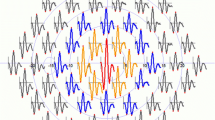Abstract
Purpose
To evaluate the effect of long-term chloroquine intake on the multifocal electroretinogram (mfERG) in female patients with and without maculopathy.
Methods
Retrospective analysis of the mfERGs recorded in three different groups: (1) patients with bilateral maculopathy having taken chloroquine, (2) patients without maculopathy having taken chloroquine, and (3) healthy control subjects (age-matched to group 2) who never took chloroquine. MfERGs of each group were averaged, and the data of each patient group were compared to the control group. The main outcome measures were N1 and P1 characteristics and the ring ratio analysis.
Results
In group 1, 11 female subjects (22 eyes) were included, group 2 consisted of nine patients (18 eyes) and group 3 of seven healthy female subjects (14 eyes). Compared with healthy controls, patients in group 1 showed significantly reduced response densities of both N1 and P1 across all ring eccentricities except ring 5. Implicit times were significantly delayed only concerning N1 (ring 4 and the sum response of the left eye of group 1). P1 implicit times showed no significant alterations in either group. Ring ratios of the response densities were significantly higher mainly concerning group 1 (N1: ring 5/ring 2 and ring 5/ring 4 of the right eye; P1: all ring ratios of the right eye and all ratios except ring 5/ring 1 and ring 5/ring 4 of the left eye). The only ring ratio being significantly higher in group 2 was P1 ring 5/ring 1 ratio of the right eye.
Conclusions
In the absence of clinically apparent maculopathy, chloroquine intake was not associated with major alterations of the mfERG.







Similar content being viewed by others
References
Marmor MF, Kellner U, Lai TY, Lyons JS, Mieler WF (2011) Revised recommendations on screening for chloroquine and hydroxychloroquine retinopathy. Ophthalmology 118:415–422
Pluta JP, Ruther K (2009) Retinal damage by (hydroxy)chloroquine intake: published evidence for an efficient ophthalmological follow-up. Klin Monbl Augenheilkd 226:891–896
Lai TY, Chan WM, Li H, Lai RY, Lam DS (2005) Multifocal electroretinographic changes in patients receiving hydroxychloroquine therapy. Am J Ophthalmol 140:794–807
Maturi RK, Yu M, Weleber RG (2004) Multifocal electroretinographic evaluation of long-term hydroxychloroquine users. Arch Ophthalmol 122:973–981
Marmor MF (2005) The dilemma of hydroxychloroquine screening: new information from the multifocal ERG. Am J Ophthalmol 140:894–895
Hood DC, Bach M, Brigell M, Keating D, Kondo M, Lyons JS et al (2012) ISCEV standard for clinical multifocal electroretinography (mfERG) (2011 edition). Doc Ophthalmol 124:1–13
Adam MK, Covert DJ, Stepien KE, Han DP (2012) Quantitative assessment of the 103-hexagon multifocal electroretinogram in detection of hydroxychloroquine retinal toxicity. Br J Ophthalmol 96:723–729
Lyons JS, Severns ML (2009) Using multifocal ERG ring ratios to detect and follow Plaquenil retinal toxicity: a review: review of mfERG ring ratios in Plaquenil toxicity. Doc Ophthalmol 118:29–36
Bergholz R, Schroeter J, Ruther K (2010) Evaluation of risk factors for retinal damage due to chloroquine and hydroxychloroquine. Br J Ophthalmol 94:1637–1642
Ruther K, Foerster J, Berndt S, Schroeter J (2007) Chloroquine/hydroxychloroquine: variability of retinotoxic cumulative doses. Ophthalmologe 104:875–879
Acknowledgments
The authors would like to thank Anja Brune and Carola Lehrhaft for the technical assistance with the electrophysiologic recordings.
Conflict of interest
None.
Author information
Authors and Affiliations
Corresponding author
Rights and permissions
About this article
Cite this article
Bergholz, R., Rüther, K., Schroeter, J. et al. Influence of chloroquine intake on the multifocal electroretinogram in patients with and without maculopathy. Doc Ophthalmol 130, 211–219 (2015). https://doi.org/10.1007/s10633-015-9486-x
Received:
Accepted:
Published:
Issue Date:
DOI: https://doi.org/10.1007/s10633-015-9486-x




